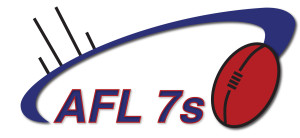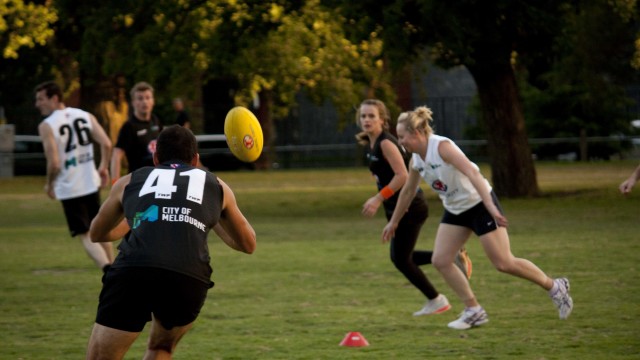
A. The field is approximately 100 metres long x 50 metres wide and is marked into 3 zones – forwards, midfielders and backs.
B. There are 4 posts located at each end of the field – 2 longer goal posts and 2 shorter behind posts.
2. Teams
A. Teams consist of 7 players on the field and any number of reserves.
B. Interchange of players may take place at any time.
C. The 7 players on the field consist of 2 forwards, 3 midfielders and 2 backs.
D. At the start of play and after each goal, the midfielders must line up in the centre of the playing field.
E. At the start of play and after each goal, the forwards and backs must line up in their respective zones.
F. Mixed teams must have a minimum of 2 females on the field at all times.
3. Playing Time
Each match consists of 2 x 20 minute halves.
4. Start of Play
A. The game is started by a basketball style jump ball between two midfield players in the centre of the ground.
B. When the umpire throws the ball up in the air, the players contesting the jump ball cannot grab the ball and play on. They must knock or palm the ball (no punching is allowed) and cannot play the ball again until it has been touched by another player.
C. After a goal, the ball is taken to the centre of the ground and restarted as in (A).
D. All players are required to start in their zones before play can commence.
5. Scoring – Goals
A. A goal (6 points) is scored when the ball is kicked between the 2 goal posts without being touched by another player.
B. In mixed games, goals scored by a female are worth 9 points (super goals).
C. Only the forwards can score for their team. All forwards are required to wear an orange bib.
D. Whilst players are encouraged to move freely around the ground, forwards must be within the forward zone to score.
E. Goals can only be kicked from marks taken in the forward zone.
F. A free kick in the forward zone will be awarded if the umpire believes a forward would have taken a mark but was illegally infringed against in the marking contest. The player may take a set shot for goal.
6. Scoring – Behinds
A. A behind (1 point) is scored when the ball is kicked between a goal & behind post, or if the ball has been touched or rushed through the goal posts by another player.
B. After a behind is scored, a member of the defending team shall bring the ball back into play via a kick, from directly in front of the goal posts.
C. When kicking the ball back into play, a member of the defending team cannot play on.
D. The ‘man on the mark’ must not stand directly in front of the player attempting to kick the ball back into play. They must go back a minimum of 10 metres from the goal posts, to give their opponent enough space.
7. Out of Bounds
A. When the ball goes out of bounds by either foot or hand, the nearest opponent shall kick the ball in.
B. If there is doubt as to which team forced the ball out of bounds, the umpire shall throw the ball up.
C. No score will be allowed when kicked from an out of bounds free kick.
8. No Tackling or Rough Play
A. No tackling or general rough play is allowed. At no stage are you permitted to be overly physical with an opponent. This rule applies in particular to protect less experienced participants, and those who are new to the game.
B. Please remember all players owe a duty of care to each other. Players must approach congested situations with caution rather than hitting them at full pace.
C. As it is a non-contact competition the following acts are not permitted and will result in an automatic free kick:
a. shoving someone in the back
b. going for hangers (high marks) by jumping on people
c. lifting your knee in a marking contest
d. charging or running through people
e. hard shepherds (soft shepherds by putting your arms out like a basketball screen are OK)
f. holding or grabbing your opponent
g. diving on the ball in the vicinity of other players
h. tripping
i. diving in front of a player in an attempt to smother their kick
Please note it makes no difference whether contact is intentional or not. By way of example, if you dive on the ball and someone falls over you as a result, the free kick will be paid against you. We are here to have fun, not injure each other.
9. Prior Opportunity
A. When a player is touched by an opponent, they have a maximum of 3 seconds to dispose of the ball by handballing or kicking. If the player fails to dispose of the ball within this period, possession will be awarded to the other team.
B. How much time the umpire allows a player to dispose of the ball depends on the circumstances and is solely at the discretion of the umpire. As an example, midfield players contesting the ball after a jump ball in the centre of the ground will normally be given a bit more time as it is a congested situation.
C. If a player has had prior opportunity to dispose of the ball when touched, it is holding the ball and a turnover will occur. An example of this is when a player attempts to evade their opponent in open play, and is touched. In this situation a free kick will be awarded.
D. If the umpire deems that a player has been touched at the same time as he/she takes possession of the ball, the player in possession will have the usual 3 seconds to dispose of the ball.
E. A legal touch can only occur between the shoulders and knees.
Please note for this rule to apply players must be in possession of the ball. If a player is not in possession of the ball, a free kick for ‘prior opportunity’ or ‘holding the ball’ will not be awarded.
10. Marking
A. Any player catching a ball directly from the kick of another player, no matter how small the distance, shall be awarded a mark.
B. If a player is about to mark the ball from a kick, a defending player is not permitted to come from behind and spoil the mark. The defending player must back off and allow their opponent to complete the mark. This is known as the safe zone.
11. Bouncing the Ball
A. A player in possession may bounce the ball only once.
12. Kicking Off the Ground
A. A player is not permitted to deliberately kick the ball off the ground.
B. If a player makes contact with the ball with his foot during the course of play, and it is deemed accidental, the umpire shall call ‘play on’ and play shall continue.
13. Send-off Rule
A. Players will be sent off for umpire abuse and/or rough play (yellow card).
B. Any incidents of aggressive rough play will result in a player’s removal from the match (red card).
